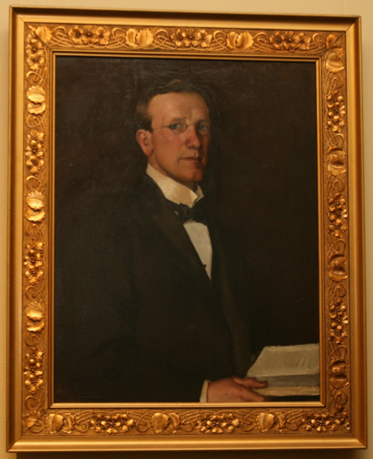2025 | Volume 26 | Issue 5
In the Hailes Room at RACS Melbourne hangs a small portrait of the Tasmanian surgeon Sir John Ramsay, painted by his brother Hugh. It was donated to the College in 1997 by Diana Ramsay AO in memory of her late husband James Stewart Ramsay AO, son of Sir John Ramsay. The portrait was painted in 1898, which makes it the oldest portrait of a Fellow in the College’s collection.

John Ramsay
John Ramsay, born in Glasgow on 26 December 1872, was the fourth son of John and Margaret Ramsay. The family migrated to Australia in 1878 and settled in Melbourne. John attended Wesley College and the University of Melbourne, graduating MBBS in 1893 with the Beaney Prize in pathology. After a year’s residency at the (Royal) Melbourne Hospital, he spent some time in Auckland before being appointed house surgeon at the Launceston General Hospital (LGH).
He was always willing to accept new techniques and was among the pioneers of Listerian methods in Australasia. John developed an interest in Roentgen’s work and began conducting X-ray experiments, which resulted in permanent scarring of his hands and face due to radiation exposure . He devised his own treatment for hydatid disease and published on the subject. In 1906 he became the first surgeon in Australasia to successfully resuscitate the heart by massage—opening the thorax of a patient who had died on the table.
In 1912, John entered private practice and established St Margaret’s Hospital, which he designed and built. He maintained a strong connection with Launceston General Hospital, serving as honorary consulting surgeon from 1912 to 1917 and again from 1925 to 1944. His involvement increased in 1929 when he joined the board of management, becoming chairman in 1933. In that role, he restructured the hospital’s administration and directed the redevelopment of its facilities.
John Ramsay was among the Foundation Fellows of RACS in 1927. He was appointed Commander of the British Empire in 1924, led the Tasmania branch of the British Medical Association in 1925, and was knighted in 1939 for contributions to surgery.
A man of wide interests, Sir John Ramsay was associated with many organisations, medical, social and recreational. These included the Medical Council of Tasmania, the Crippled Children’s Association, Red Cross, Rotary, the Tasmanian Aero Club and the Royal Automobile Association of Tasmania. He died in Launceston on 6 February 1944.
Sir John Ramsay’s younger brother, Hugh, is generally regarded as the finest portrait painter Australia has produced. Although his brief but brilliant career was tragically cut short, he exercised a profound influence on Australian artists. Born in Glasgow on 25 May 1877, he came to Australia as a young child. He attended Essendon Grammar School and then the National Gallery schools, studying painting under Bernard Hall and Frederick McCubbin. He also found a friend and mentor in Sir John Longstaff.

Hugh Ramsay
In 1900 Hugh left for Europe, reaching Paris, where he took up residence in a dilapidated artist’s studio in Montparnasse. He spent nearly two years here, leading to an exhibition at the New Salon in 1902 that brought him international recognition.
During this time, he met Dame Nellie Melba, who invited him to London to paint her portrait. Through her and Sir Longstaff, he entered influential social circles that expanded his opportunities. But on the verge of triumph, he was diagnosed with tuberculosis— the result of poor living in Paris—and forced to return to Australia. He died at Clydebank, the family mansion in Essendon, on 5 March 1906, at the age of 28 years.
A third brother, William (1868-1914), went into manufacturing, and became the founder of an Australasian commercial icon, the Kiwi Polish Co.
The Sir John Ramsay Award - Memorial Lecture and Medal has been initiated by the James and Diana Ramsay Foundation and the Launceston General Hospital Historical Society. It is funded by the James Ramsay Research Grant.
The Award incorporates a lecture and medal to commemorate Sir John Ramsay and is awarded annually to a prominent surgeon at the RACS ASC as a visiting lecturer.
Today, Sir John Ramsay still holds a prominent presence at the LGH with a medical library named in his honour, which holds duplicate copies of his original handwritten surgical notes.